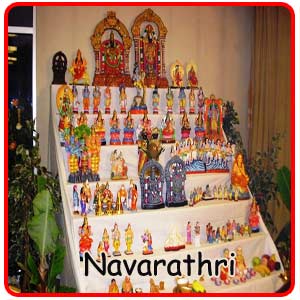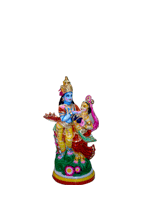 Navrathri - the Most Significant Festival of the Hindus
Navrathri - the Most Significant Festival of the Hindus
Navrathri the most significant festival of the Hindus falls on the lunar month of Ashwin which is either in September or October and is celebrated with all religious and spiritual significance for the next nine months in India. Goddess Durga is worshipped during Navrathri and people celebrate it by various ways like fasting, singing religious songs, dancing, following vegetarian diets and much more. Dandiya and Garba play a major part of the festival especially in North India. At the time of Navrathri people strictly adhere to various rituals like continuous burning of lamp, fasting, staying awake for the night, worshipping a virgin girl, presenting various offerings to the Goddess, singing and dancing to seraphic tunes, etc. The people of the Gujarati community are more into the celebration of Navrathri with devoted significance and enthusiasm. This festival of joy and festivity enhances the devotees in different ways like physically, mentally and spiritually for they worship Goddess Durga in three different forms.
 Festival of Navrathri goes for a Period of Nine Days
Festival of Navrathri goes for a Period of Nine Days
-Though the festival of Navrathri goes for a period of nine days the last four days are very important and quite significant. The meaning of Navrathri is nine days so after the celebration for nine days, on the tenth day the idol of Goddess Durga which is worshipped during the period is immersed in holy water after the pooja is over. All the nine days of Navrathri has a unique meaning and importance for on each day one form of Goddess is worshipped and they are namely Kushmanda, Skandmata, Katyayani, Mahagauri, Siddhidhatri, Kalratri, Chandraghanta, Shailpurti and Brahmacharini. Whereas there are other beliefs like it is only three form of Goddess which is worshipped and they are the trinity of God. Though the people of different states celebrate with varying features the dedication and the devotion remains the same throughout the country. It is celebrated with great passion and fervor. During this festival of celebration the people dress up in the best of their traditional attires and worship huge idols of Goddess Durga to give them the strength and courage to fight against the evil forces.
 Dussehra is Celebrated as Lord Rama's Victory
Dussehra is Celebrated as Lord Rama's Victory
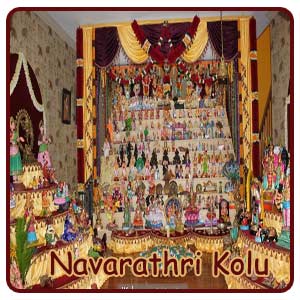
 The Brilliant Light of the Diya
The Brilliant Light of the Diya
-The brilliant light of the Diya is said to ward off all kinds of negative energies surrounding us. Due to the constant vibrations from the lamp the soul benefits at the level of spiritual emotion and feels the experience of harmony and bliss. Also factors like purity and divine consciousness in the environment enhances. Another important ritual which is followed at the time of Navrathri is fasting by which the embodied soul of the individual is benefitted up to 3% and depending upon one's spiritual yearning, the six basic vices (shad-ripu) also get reduced. Some people follow the ritual of fasting on all the nine days of the festival of Navrathri whereas some observe it on the first and the last day or the last day and the day before it. Fasting is not that the devotees totally abstain themselves from food for the whole day but instead they eat some special type of fasting dishes.
 Navarathri-abstaining from food and sleep
Navarathri-abstaining from food and sleep
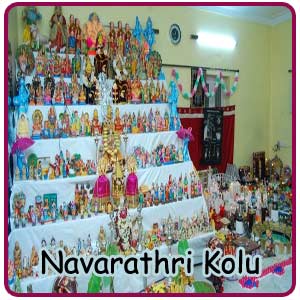
 Worship of virgin girls
Worship of virgin girls
- Also men of particular community do not shave or cut their hair during this period. People generally avoid dressing up themselves in black clothes but instead go in for wearing red and yellow colour for it is believed that is supposed to be Goddess Durga's favourite colour.The people follow the ritual of also worshipping young and virgin girls on all the nine days of navrathri for they consider them to be the form of Shakthi. A virgin girl is a symbol of unmanifested energy and by worshipping her the unmanifested energy in her gets activated. Due to this the radiant frequencies in the universe get attracted and the devotee benefits by it. People apart from worshipping virgin girls also feed them with sweets and different types of traditional and delicious food items. They believe that it is the offering they give it to Goddess Durga. The preparation of spiritually pure dishes at the time of Navrathri is also a very important part of the rituals followed during Navrathri. Special food like sweets made of chickpeas and jaggery and plain curry made of yellow lentils are all part of the Navrathri special food.
 Food and Garba during Navarathri
Food and Garba during Navarathri
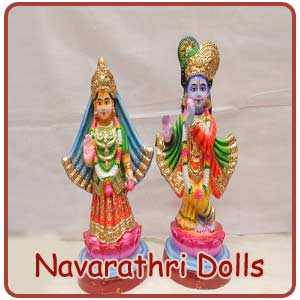
According to Hinduism Garba is the action of singing of devotional songs and hymns in praise of Goddess Durga accompanied by rhythmic clapping of hands or tapping of sticks. The devotional songs are mainly sung to awake Goddess Shakthhi from Her meditation through the medium of the manifest spiritual practice of rhythmic clapping, and appealing to her to assume the destructive form for her activity in the Universe. The Garba dance is a kind of traditional folk dance of the people of Gujarat and when compared to the whole country the people of Gujarat celebrate Navrathri with great religious fervor.
 Significance of claps in Garba Dance
Significance of claps in Garba Dance
-The significance behind the musical rhythm of three claps of either hands or sticks is because by doing so the destroyer form of the Goddess is awakened through the frequencies of desire, action and knowledge, representing the Bramha, Vishnu and Maheshwaran for they are the important manifest energies of God. Now the Goddess of destroyer Durga Devi awakens slowly and is channeled through these three energies. Thus by clapping three times the energy of the Goddess sankalpa gets started. Each clap means different for the first clap is associated to Lord Brahma which is significant by the energy of desire. Thus by the clapping the wishes and desires of the Lord gets activated and grants permission to the wishes in the mind of the embodied soul. By the second clap the action related waves of the Vishnu principle give energy to the embodied soul for performing actions. By the action of the third clap the knowledge waves of the Shiva principle bring about the actual act and from its result give the desired fruits to the embodied soul.
 Navrathri jyoti
Navrathri jyoti
